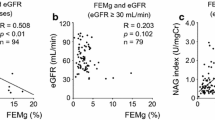Abstract
Urinary N-acetyl-beta-D glucosaminidase (NAG) is a sensitive biomarker of renal parenchymal disease. The aim of this study was to investigate variations in the levels of NAG excretion among different sub-groups of nephrotic syndrome (first episode, relapsers, and resistant) and its prediction based on proteinuria. Thirty-five patients with idiopathic nephrotic syndrome, aged 1–12 years, as well as 15 age- and gender-matched normal children (controls) were enrolled in the study. Among the 35 patients, ten were classified with first episode nephrotic syndrome (FENS), 17 with relapsing nephrotic syndrome (RNS), and eight with steroid-resistant nephrotic syndrome (SRNS). Urinary NAG/creatinine levels were significantly increased in SRNS patients as compared to FENS and RNS patients (p < 0.001); the FENS and RNS groups had comparable levels. A urinary NAG/creatinine value of ≤108.9 U/g was found to identify steroid-sensitive patients with a sensitivity, specificity, positive predictive value, and negative predictive value of 78.8, 100, 100 and 77.7%, respectively. Significant correlations were found between experimental and predicted values of urinary NAG/creatinine in steroid sensitive nephrotic syndrome (SSNS) (R 2 = 0.9643) and SRNS patients (R 2 = 0.9823). Urinary NAG/creatinine values were found to be higher in SRNS than SSNS patients and have moderate predictive value for steroid responsiveness. This level can be obtained based on urinary protein/creatinine ratio or 24 h urinary protein levels.




Similar content being viewed by others
Abbreviations
- FENS:
-
First episode nephrotic syndrome
- MCD:
-
Minimal change disease
- NAG:
-
N-acetyl-beta-D glucosaminidase
- RNS:
-
Relapsing nephrotic syndrome
- SRNS:
-
Steroid-resistant nephrotic syndrome
- SSNS:
-
Steroid-sensitive nephrotic syndrome
References
Eddy AA, Symons JM (2003) Nephrotic syndrome in childhood. Lancet 362:629–639
Price RG (1992) The role of NAG (N-acetyl-beta-D-glucosaminidase) in the diagnosis of kidney disease including the monitoring of nephrotoxicity. Clin Nephrol 38:S14–S19
Le Hir M, Dubach UC, Schmidt U (1979) Quantitative distribution of lysosomal hydrolases in the rat nephron. Histochemistry 63:245–251
D’Amico G, Ferrario F, Rastaldi MP (1995) Tubulointerstitial damage in glomerular diseases: its role in the progression of renal damage. Am J Kidney Dis 26:124–132
Dieppe PA, Doyle DV, Burry HC (1978) Renal damage during treatment with antirheumatic drugs. Br Med J 2:664
Mansell MA, Jones NF, Ziroyannis PN, Marson WS, Tucker SM (1978) Measurement of urinary NAG and the detection of renovascular hypertension. Contrib Nephrol 11:202–204
Valles P, Peralta M, Carrizo L, Martin L, Principi I, Gonzalez A, Manucha W (2000) Follow-up of steroid resistant nephrotic syndrome: tubular proteinuria and enzymuria. Pediatr Nephrol 15:252–258
Caliskan S, Hacibekiroglu M, Sever L, Ozbay G, Arisoy N (1996) Urinary N-acetyl-beta-D-glucosaminidase and beta 2-microglobulin excretion in primary nephrotic children. Nephron 74:401–404
Bagga A (2008) Revised guidelines for management of steroid-sensitive nephrotic syndrome. Indian J Nephrol 18:31–39
Gulati A, Bagga A, Gulati S, Mehta KP, Vijayakumar M (2009) Management of steroid resistant nephrotic syndrome. Indian Society of Pediatric Nephrology Guidelines. Indian Pediatr 46:35–47
Kunmin CM, Chesney RW, Craig WA, England AC, De Angelis C (1978) Enzymuria as a marker of renal injury and disease: studies of N-acetyl- beta-glucosaminidase in the general population and in patients with renal disease. Pediatrics 62:751–760
Gupta K, Maiti B, Mishra PK, Srivastava P (2009) Fuzzy rule-based prediction of lovastatin productivity in continuous mode using pellets of Aspergillus terreus in an airlift reactor. J Biochem Tech 2:138–143
Rennke HG (1994) How does glomerular epithelial cell injury contribute to progressive glomerular damage? Kidney Int Suppl 45:S58–S63
Khurana M, Traum AZ, Avivado M, Wells MP, Guerrero M, Grall F, Libermann TA, Schachter AD (2006) Urine proteomic profiling of pediatric nephrotic syndrome. Pediatr Nephrol 21:1257–1265
Woroniecki RP, Orlova TN, Mendelev N, Shatat IF, Hailpern SM, Kaskel FJ, Goliogorsky MS, O’Riordan E (2006) Urinary proteome of steroid-sensitive and steroid-resistant idiopathic nephrotic syndrome of childhood. Am J Nephrol 26:258–267
Huang YJ, Huang SM, Zhang AH, Zheng G, Chen RH (2007) Comparison of urinary proteomics between steroid-sensitive and steroid-resistant minimal change nephrotic syndrome in children. Nan Fang Yi Ke Da Xue Bao 27:1507–1510
Bazzi C, Petrini C, Rizza V, Arrigo G, Napodano P, Paparella M, D’Amico G (2002) Urinary N-acetyl-beta-glucasaminidase excretion is a marker of tubular cell dysfunction and a predictor of outcome in primary glomerulonephritis. Nephrol Dial Transplant 17:1890–1896
Bosomworth MP, Aparicio SR, Hay AWM (1999) Urine N-acetyl-b-D-glucosaminidase—a marker of tubular damage? Nephrol Dial Transplant 14:620–626
Rustom R, Castigan M, Shenkin A (1998) Proteinuria and renal tubular damage: urinary N-acetyl-b-D-glucosaminidase and isoenzymes in dissimilar renal disease. Am J Nephrol 18:179–185
Acknowledgments
The authors are grateful to Dr. Narendra K Tiwary for helping with the statistical analysis and to the Finance Officer of Banaras Hindu University for providing the research grant which enabled us to carry out this study.
Author information
Authors and Affiliations
Corresponding author
Rights and permissions
About this article
Cite this article
Mishra, O.P., Jain, P., Srivastava, P. et al. Urinary N-acetyl-beta-D glucosaminidase (NAG) level in idiopathic nephrotic syndrome. Pediatr Nephrol 27, 589–596 (2012). https://doi.org/10.1007/s00467-011-2041-4
Received:
Revised:
Accepted:
Published:
Issue Date:
DOI: https://doi.org/10.1007/s00467-011-2041-4




